Child Sex Abuse Acts: Constitutional Validity
VerifiedAdded on 2019/10/12
|8
|2252
|172
Essay
AI Summary
This essay examines the constitutional validity of two Australian acts addressing child sex abuse: the Commonwealth's Child Sex Abuse (Justice for Survivors) Act 2016 and New South Wales' Consequences for Cover Ups Act 2016. Both acts stem from Royal Commission recommendations aiming to improve justice for survivors by removing time limits on legal action and addressing institutional cover-ups. The essay analyzes the acts' alignment with the Australian Constitution, highlighting potential discrepancies. Concerns are raised regarding the conflation of individual injustice with national crisis, the potential for bias in powerful offices involved in the process, and the balance between procedural fairness and efficient justice. While acknowledging the acts' overall constitutional validity, the essay suggests improvements to address these potential flaws, emphasizing the need for clear definitions, accountability mechanisms, and safeguards against bias to ensure fair and effective justice for survivors.
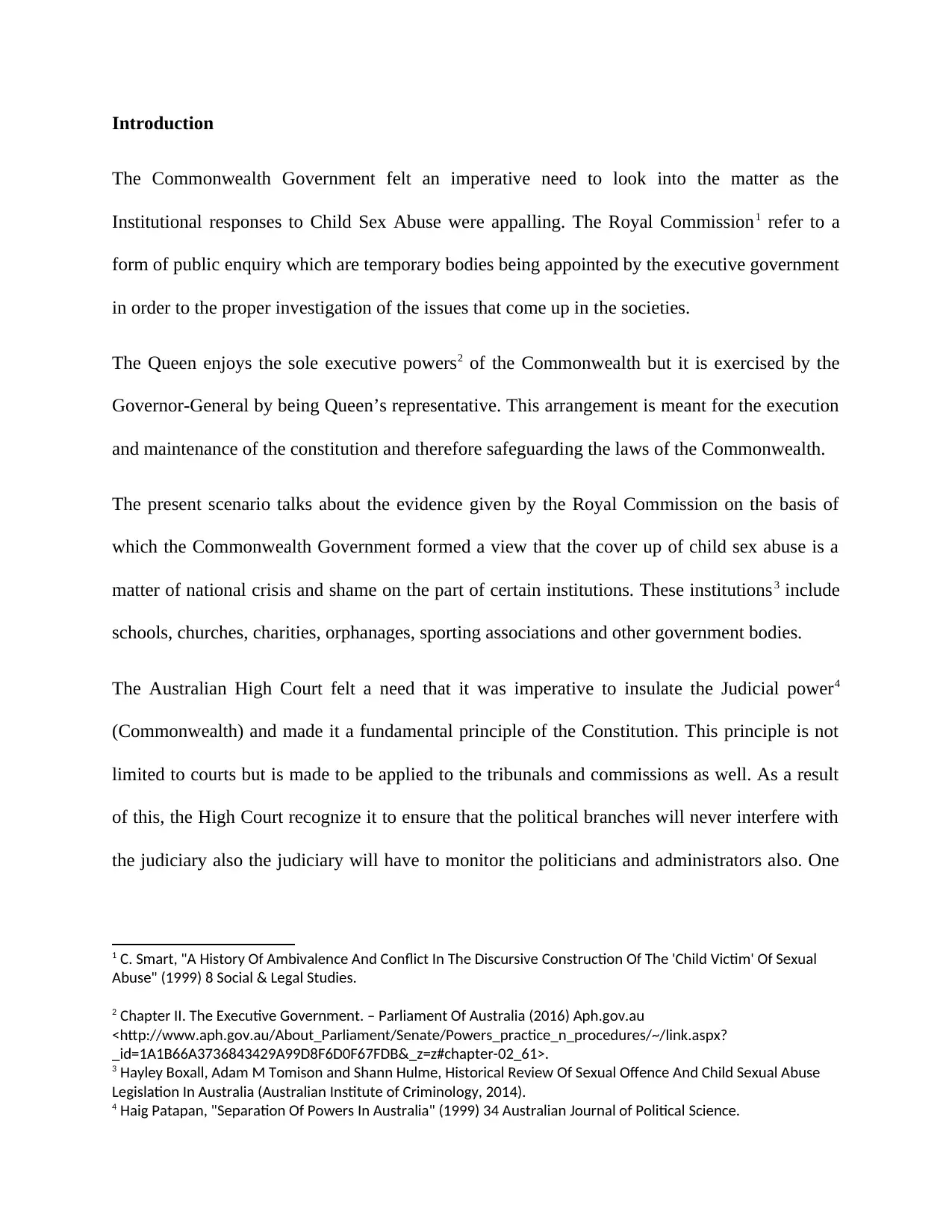
Introduction
The Commonwealth Government felt an imperative need to look into the matter as the
Institutional responses to Child Sex Abuse were appalling. The Royal Commission1 refer to a
form of public enquiry which are temporary bodies being appointed by the executive government
in order to the proper investigation of the issues that come up in the societies.
The Queen enjoys the sole executive powers2 of the Commonwealth but it is exercised by the
Governor-General by being Queen’s representative. This arrangement is meant for the execution
and maintenance of the constitution and therefore safeguarding the laws of the Commonwealth.
The present scenario talks about the evidence given by the Royal Commission on the basis of
which the Commonwealth Government formed a view that the cover up of child sex abuse is a
matter of national crisis and shame on the part of certain institutions. These institutions3 include
schools, churches, charities, orphanages, sporting associations and other government bodies.
The Australian High Court felt a need that it was imperative to insulate the Judicial power4
(Commonwealth) and made it a fundamental principle of the Constitution. This principle is not
limited to courts but is made to be applied to the tribunals and commissions as well. As a result
of this, the High Court recognize it to ensure that the political branches will never interfere with
the judiciary also the judiciary will have to monitor the politicians and administrators also. One
1 C. Smart, "A History Of Ambivalence And Conflict In The Discursive Construction Of The 'Child Victim' Of Sexual
Abuse" (1999) 8 Social & Legal Studies.
2 Chapter II. The Executive Government. – Parliament Of Australia (2016) Aph.gov.au
<http://www.aph.gov.au/About_Parliament/Senate/Powers_practice_n_procedures/~/link.aspx?
_id=1A1B66A3736843429A99D8F6D0F67FDB&_z=z#chapter-02_61>.
3 Hayley Boxall, Adam M Tomison and Shann Hulme, Historical Review Of Sexual Offence And Child Sexual Abuse
Legislation In Australia (Australian Institute of Criminology, 2014).
4 Haig Patapan, "Separation Of Powers In Australia" (1999) 34 Australian Journal of Political Science.
The Commonwealth Government felt an imperative need to look into the matter as the
Institutional responses to Child Sex Abuse were appalling. The Royal Commission1 refer to a
form of public enquiry which are temporary bodies being appointed by the executive government
in order to the proper investigation of the issues that come up in the societies.
The Queen enjoys the sole executive powers2 of the Commonwealth but it is exercised by the
Governor-General by being Queen’s representative. This arrangement is meant for the execution
and maintenance of the constitution and therefore safeguarding the laws of the Commonwealth.
The present scenario talks about the evidence given by the Royal Commission on the basis of
which the Commonwealth Government formed a view that the cover up of child sex abuse is a
matter of national crisis and shame on the part of certain institutions. These institutions3 include
schools, churches, charities, orphanages, sporting associations and other government bodies.
The Australian High Court felt a need that it was imperative to insulate the Judicial power4
(Commonwealth) and made it a fundamental principle of the Constitution. This principle is not
limited to courts but is made to be applied to the tribunals and commissions as well. As a result
of this, the High Court recognize it to ensure that the political branches will never interfere with
the judiciary also the judiciary will have to monitor the politicians and administrators also. One
1 C. Smart, "A History Of Ambivalence And Conflict In The Discursive Construction Of The 'Child Victim' Of Sexual
Abuse" (1999) 8 Social & Legal Studies.
2 Chapter II. The Executive Government. – Parliament Of Australia (2016) Aph.gov.au
<http://www.aph.gov.au/About_Parliament/Senate/Powers_practice_n_procedures/~/link.aspx?
_id=1A1B66A3736843429A99D8F6D0F67FDB&_z=z#chapter-02_61>.
3 Hayley Boxall, Adam M Tomison and Shann Hulme, Historical Review Of Sexual Offence And Child Sexual Abuse
Legislation In Australia (Australian Institute of Criminology, 2014).
4 Haig Patapan, "Separation Of Powers In Australia" (1999) 34 Australian Journal of Political Science.
Paraphrase This Document
Need a fresh take? Get an instant paraphrase of this document with our AI Paraphraser
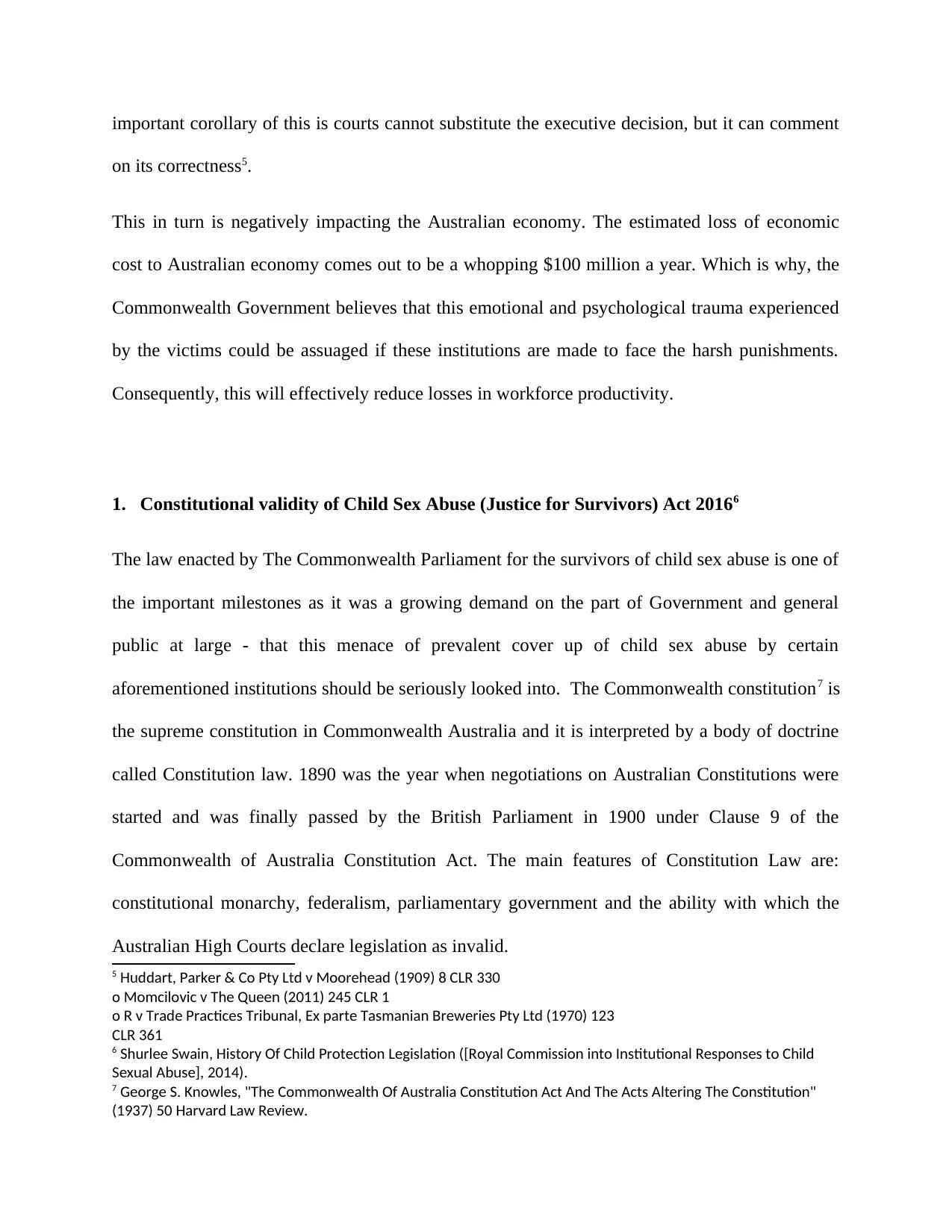
important corollary of this is courts cannot substitute the executive decision, but it can comment
on its correctness5.
This in turn is negatively impacting the Australian economy. The estimated loss of economic
cost to Australian economy comes out to be a whopping $100 million a year. Which is why, the
Commonwealth Government believes that this emotional and psychological trauma experienced
by the victims could be assuaged if these institutions are made to face the harsh punishments.
Consequently, this will effectively reduce losses in workforce productivity.
1. Constitutional validity of Child Sex Abuse (Justice for Survivors) Act 20166
The law enacted by The Commonwealth Parliament for the survivors of child sex abuse is one of
the important milestones as it was a growing demand on the part of Government and general
public at large - that this menace of prevalent cover up of child sex abuse by certain
aforementioned institutions should be seriously looked into. The Commonwealth constitution7 is
the supreme constitution in Commonwealth Australia and it is interpreted by a body of doctrine
called Constitution law. 1890 was the year when negotiations on Australian Constitutions were
started and was finally passed by the British Parliament in 1900 under Clause 9 of the
Commonwealth of Australia Constitution Act. The main features of Constitution Law are:
constitutional monarchy, federalism, parliamentary government and the ability with which the
Australian High Courts declare legislation as invalid.
5 Huddart, Parker & Co Pty Ltd v Moorehead (1909) 8 CLR 330
o Momcilovic v The Queen (2011) 245 CLR 1
o R v Trade Practices Tribunal, Ex parte Tasmanian Breweries Pty Ltd (1970) 123
CLR 361
6 Shurlee Swain, History Of Child Protection Legislation ([Royal Commission into Institutional Responses to Child
Sexual Abuse], 2014).
7 George S. Knowles, "The Commonwealth Of Australia Constitution Act And The Acts Altering The Constitution"
(1937) 50 Harvard Law Review.
on its correctness5.
This in turn is negatively impacting the Australian economy. The estimated loss of economic
cost to Australian economy comes out to be a whopping $100 million a year. Which is why, the
Commonwealth Government believes that this emotional and psychological trauma experienced
by the victims could be assuaged if these institutions are made to face the harsh punishments.
Consequently, this will effectively reduce losses in workforce productivity.
1. Constitutional validity of Child Sex Abuse (Justice for Survivors) Act 20166
The law enacted by The Commonwealth Parliament for the survivors of child sex abuse is one of
the important milestones as it was a growing demand on the part of Government and general
public at large - that this menace of prevalent cover up of child sex abuse by certain
aforementioned institutions should be seriously looked into. The Commonwealth constitution7 is
the supreme constitution in Commonwealth Australia and it is interpreted by a body of doctrine
called Constitution law. 1890 was the year when negotiations on Australian Constitutions were
started and was finally passed by the British Parliament in 1900 under Clause 9 of the
Commonwealth of Australia Constitution Act. The main features of Constitution Law are:
constitutional monarchy, federalism, parliamentary government and the ability with which the
Australian High Courts declare legislation as invalid.
5 Huddart, Parker & Co Pty Ltd v Moorehead (1909) 8 CLR 330
o Momcilovic v The Queen (2011) 245 CLR 1
o R v Trade Practices Tribunal, Ex parte Tasmanian Breweries Pty Ltd (1970) 123
CLR 361
6 Shurlee Swain, History Of Child Protection Legislation ([Royal Commission into Institutional Responses to Child
Sexual Abuse], 2014).
7 George S. Knowles, "The Commonwealth Of Australia Constitution Act And The Acts Altering The Constitution"
(1937) 50 Harvard Law Review.
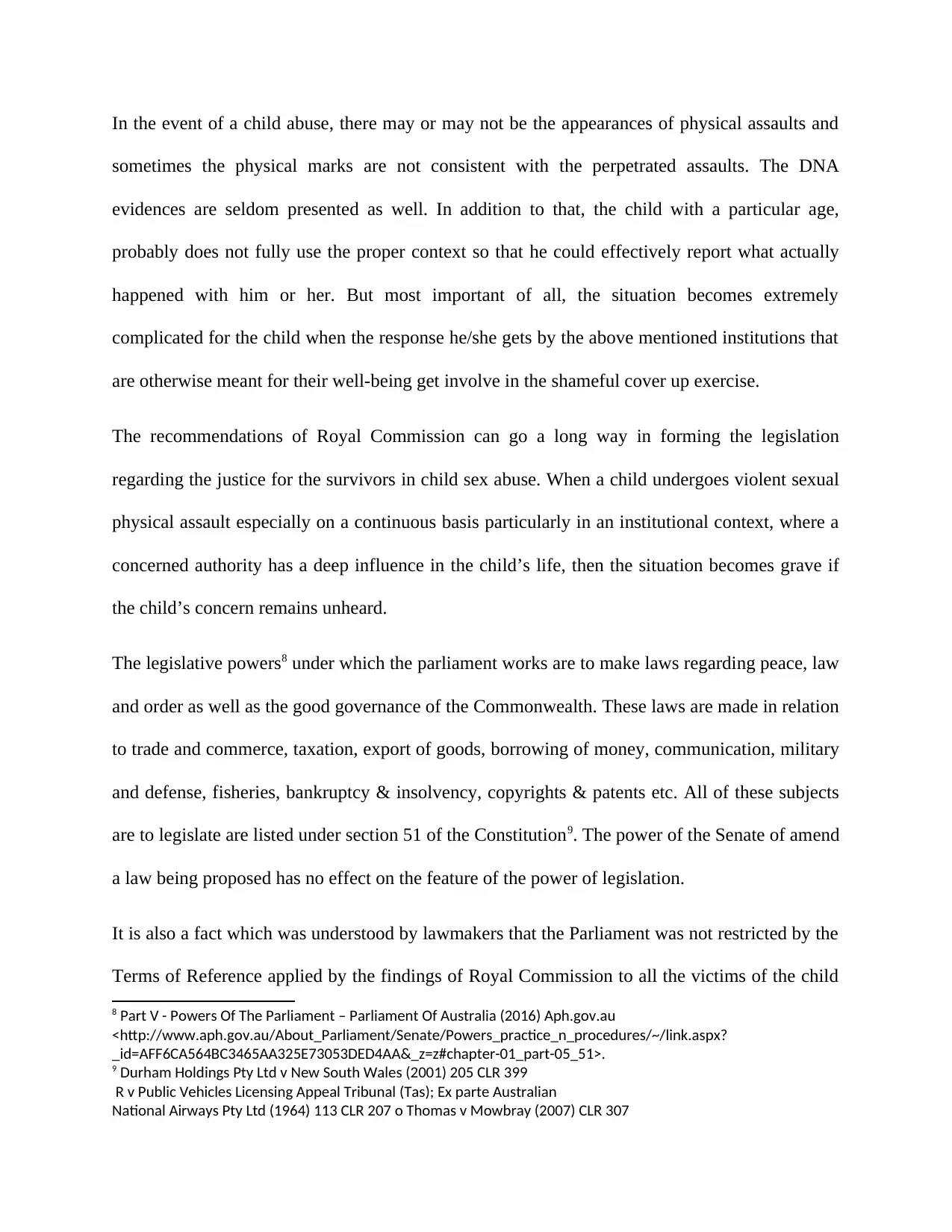
In the event of a child abuse, there may or may not be the appearances of physical assaults and
sometimes the physical marks are not consistent with the perpetrated assaults. The DNA
evidences are seldom presented as well. In addition to that, the child with a particular age,
probably does not fully use the proper context so that he could effectively report what actually
happened with him or her. But most important of all, the situation becomes extremely
complicated for the child when the response he/she gets by the above mentioned institutions that
are otherwise meant for their well-being get involve in the shameful cover up exercise.
The recommendations of Royal Commission can go a long way in forming the legislation
regarding the justice for the survivors in child sex abuse. When a child undergoes violent sexual
physical assault especially on a continuous basis particularly in an institutional context, where a
concerned authority has a deep influence in the child’s life, then the situation becomes grave if
the child’s concern remains unheard.
The legislative powers8 under which the parliament works are to make laws regarding peace, law
and order as well as the good governance of the Commonwealth. These laws are made in relation
to trade and commerce, taxation, export of goods, borrowing of money, communication, military
and defense, fisheries, bankruptcy & insolvency, copyrights & patents etc. All of these subjects
are to legislate are listed under section 51 of the Constitution9. The power of the Senate of amend
a law being proposed has no effect on the feature of the power of legislation.
It is also a fact which was understood by lawmakers that the Parliament was not restricted by the
Terms of Reference applied by the findings of Royal Commission to all the victims of the child
8 Part V - Powers Of The Parliament – Parliament Of Australia (2016) Aph.gov.au
<http://www.aph.gov.au/About_Parliament/Senate/Powers_practice_n_procedures/~/link.aspx?
_id=AFF6CA564BC3465AA325E73053DED4AA&_z=z#chapter-01_part-05_51>.
9 Durham Holdings Pty Ltd v New South Wales (2001) 205 CLR 399
R v Public Vehicles Licensing Appeal Tribunal (Tas); Ex parte Australian
National Airways Pty Ltd (1964) 113 CLR 207 o Thomas v Mowbray (2007) CLR 307
sometimes the physical marks are not consistent with the perpetrated assaults. The DNA
evidences are seldom presented as well. In addition to that, the child with a particular age,
probably does not fully use the proper context so that he could effectively report what actually
happened with him or her. But most important of all, the situation becomes extremely
complicated for the child when the response he/she gets by the above mentioned institutions that
are otherwise meant for their well-being get involve in the shameful cover up exercise.
The recommendations of Royal Commission can go a long way in forming the legislation
regarding the justice for the survivors in child sex abuse. When a child undergoes violent sexual
physical assault especially on a continuous basis particularly in an institutional context, where a
concerned authority has a deep influence in the child’s life, then the situation becomes grave if
the child’s concern remains unheard.
The legislative powers8 under which the parliament works are to make laws regarding peace, law
and order as well as the good governance of the Commonwealth. These laws are made in relation
to trade and commerce, taxation, export of goods, borrowing of money, communication, military
and defense, fisheries, bankruptcy & insolvency, copyrights & patents etc. All of these subjects
are to legislate are listed under section 51 of the Constitution9. The power of the Senate of amend
a law being proposed has no effect on the feature of the power of legislation.
It is also a fact which was understood by lawmakers that the Parliament was not restricted by the
Terms of Reference applied by the findings of Royal Commission to all the victims of the child
8 Part V - Powers Of The Parliament – Parliament Of Australia (2016) Aph.gov.au
<http://www.aph.gov.au/About_Parliament/Senate/Powers_practice_n_procedures/~/link.aspx?
_id=AFF6CA564BC3465AA325E73053DED4AA&_z=z#chapter-01_part-05_51>.
9 Durham Holdings Pty Ltd v New South Wales (2001) 205 CLR 399
R v Public Vehicles Licensing Appeal Tribunal (Tas); Ex parte Australian
National Airways Pty Ltd (1964) 113 CLR 207 o Thomas v Mowbray (2007) CLR 307
⊘ This is a preview!⊘
Do you want full access?
Subscribe today to unlock all pages.

Trusted by 1+ million students worldwide
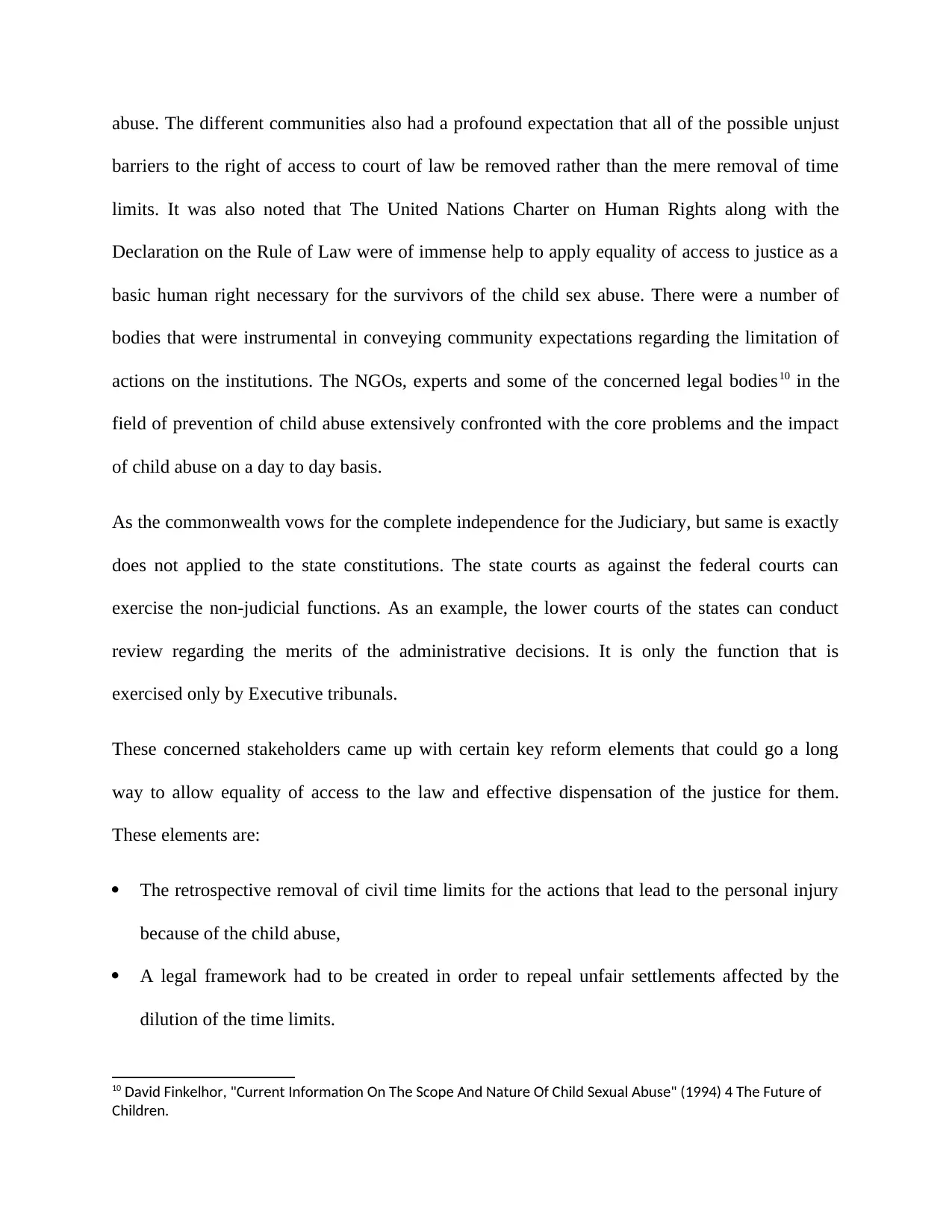
abuse. The different communities also had a profound expectation that all of the possible unjust
barriers to the right of access to court of law be removed rather than the mere removal of time
limits. It was also noted that The United Nations Charter on Human Rights along with the
Declaration on the Rule of Law were of immense help to apply equality of access to justice as a
basic human right necessary for the survivors of the child sex abuse. There were a number of
bodies that were instrumental in conveying community expectations regarding the limitation of
actions on the institutions. The NGOs, experts and some of the concerned legal bodies10 in the
field of prevention of child abuse extensively confronted with the core problems and the impact
of child abuse on a day to day basis.
As the commonwealth vows for the complete independence for the Judiciary, but same is exactly
does not applied to the state constitutions. The state courts as against the federal courts can
exercise the non-judicial functions. As an example, the lower courts of the states can conduct
review regarding the merits of the administrative decisions. It is only the function that is
exercised only by Executive tribunals.
These concerned stakeholders came up with certain key reform elements that could go a long
way to allow equality of access to the law and effective dispensation of the justice for them.
These elements are:
The retrospective removal of civil time limits for the actions that lead to the personal injury
because of the child abuse,
A legal framework had to be created in order to repeal unfair settlements affected by the
dilution of the time limits.
10 David Finkelhor, "Current Information On The Scope And Nature Of Child Sexual Abuse" (1994) 4 The Future of
Children.
barriers to the right of access to court of law be removed rather than the mere removal of time
limits. It was also noted that The United Nations Charter on Human Rights along with the
Declaration on the Rule of Law were of immense help to apply equality of access to justice as a
basic human right necessary for the survivors of the child sex abuse. There were a number of
bodies that were instrumental in conveying community expectations regarding the limitation of
actions on the institutions. The NGOs, experts and some of the concerned legal bodies10 in the
field of prevention of child abuse extensively confronted with the core problems and the impact
of child abuse on a day to day basis.
As the commonwealth vows for the complete independence for the Judiciary, but same is exactly
does not applied to the state constitutions. The state courts as against the federal courts can
exercise the non-judicial functions. As an example, the lower courts of the states can conduct
review regarding the merits of the administrative decisions. It is only the function that is
exercised only by Executive tribunals.
These concerned stakeholders came up with certain key reform elements that could go a long
way to allow equality of access to the law and effective dispensation of the justice for them.
These elements are:
The retrospective removal of civil time limits for the actions that lead to the personal injury
because of the child abuse,
A legal framework had to be created in order to repeal unfair settlements affected by the
dilution of the time limits.
10 David Finkelhor, "Current Information On The Scope And Nature Of Child Sexual Abuse" (1994) 4 The Future of
Children.
Paraphrase This Document
Need a fresh take? Get an instant paraphrase of this document with our AI Paraphraser

Furnish the relevant measures that may potentially limit the unfair grounds based on which
any particular institution has the proclivity to seek a stay of the court proceedings.
The civil jury trials would be reinstituted for convening civil actions regarding personal
injury that might arise from child abuse.
The institutional offending11 related to the child abuse was exposed as something very unique,
widespread as well as systemic web of offence that in turn needs a unique legislative solution.
The Act also needs to provide safeguards as the restrictions should only be limited to those
institutions that have acted to cause a delay in the proceedings of delay for the justice.
The procedure for the amendment of the law12 is made by passing it with the help of the absolute
majority of each house of the parliament which in turn needs to be submitted in every state and
territory in not less than 2 months and not more than 6 months. Finally it will be voted by the
electors to qualify as a law in the House of Representatives. The vote of the electors shall be
taken in a manner prescribed by the parliament. When the voting takes place and majority of the
voters voted to alter the law, then it is presented to the Governor-General for the Queen’s
assent13.
11 Marietta Higgs, "Child Sexual Abuse: Critical Perspectives On Prevention, Intervention And Treatment" (1993) 17
Child Abuse & Neglect.
12 Chapter VIII. Alteration Of The Constitution. – Parliament Of Australia (2016) Aph.gov.au
<http://www.aph.gov.au/About_Parliament/Senate/Powers_practice_n_procedures/~/link.aspx?
_id=630FA7763BE64933B172A7D7E1615ADA&_z=z#chapter-08_128>.
13 South-Eastern Drainage Board (SA) v Savings Bank of South Australia (1939)
62 CLR 603
West Lakes Ltd v South Australia (1980) 25 SASR 389 o Attorney-General (WA) v Marquet (2003) 217 CLR 545
any particular institution has the proclivity to seek a stay of the court proceedings.
The civil jury trials would be reinstituted for convening civil actions regarding personal
injury that might arise from child abuse.
The institutional offending11 related to the child abuse was exposed as something very unique,
widespread as well as systemic web of offence that in turn needs a unique legislative solution.
The Act also needs to provide safeguards as the restrictions should only be limited to those
institutions that have acted to cause a delay in the proceedings of delay for the justice.
The procedure for the amendment of the law12 is made by passing it with the help of the absolute
majority of each house of the parliament which in turn needs to be submitted in every state and
territory in not less than 2 months and not more than 6 months. Finally it will be voted by the
electors to qualify as a law in the House of Representatives. The vote of the electors shall be
taken in a manner prescribed by the parliament. When the voting takes place and majority of the
voters voted to alter the law, then it is presented to the Governor-General for the Queen’s
assent13.
11 Marietta Higgs, "Child Sexual Abuse: Critical Perspectives On Prevention, Intervention And Treatment" (1993) 17
Child Abuse & Neglect.
12 Chapter VIII. Alteration Of The Constitution. – Parliament Of Australia (2016) Aph.gov.au
<http://www.aph.gov.au/About_Parliament/Senate/Powers_practice_n_procedures/~/link.aspx?
_id=630FA7763BE64933B172A7D7E1615ADA&_z=z#chapter-08_128>.
13 South-Eastern Drainage Board (SA) v Savings Bank of South Australia (1939)
62 CLR 603
West Lakes Ltd v South Australia (1980) 25 SASR 389 o Attorney-General (WA) v Marquet (2003) 217 CLR 545
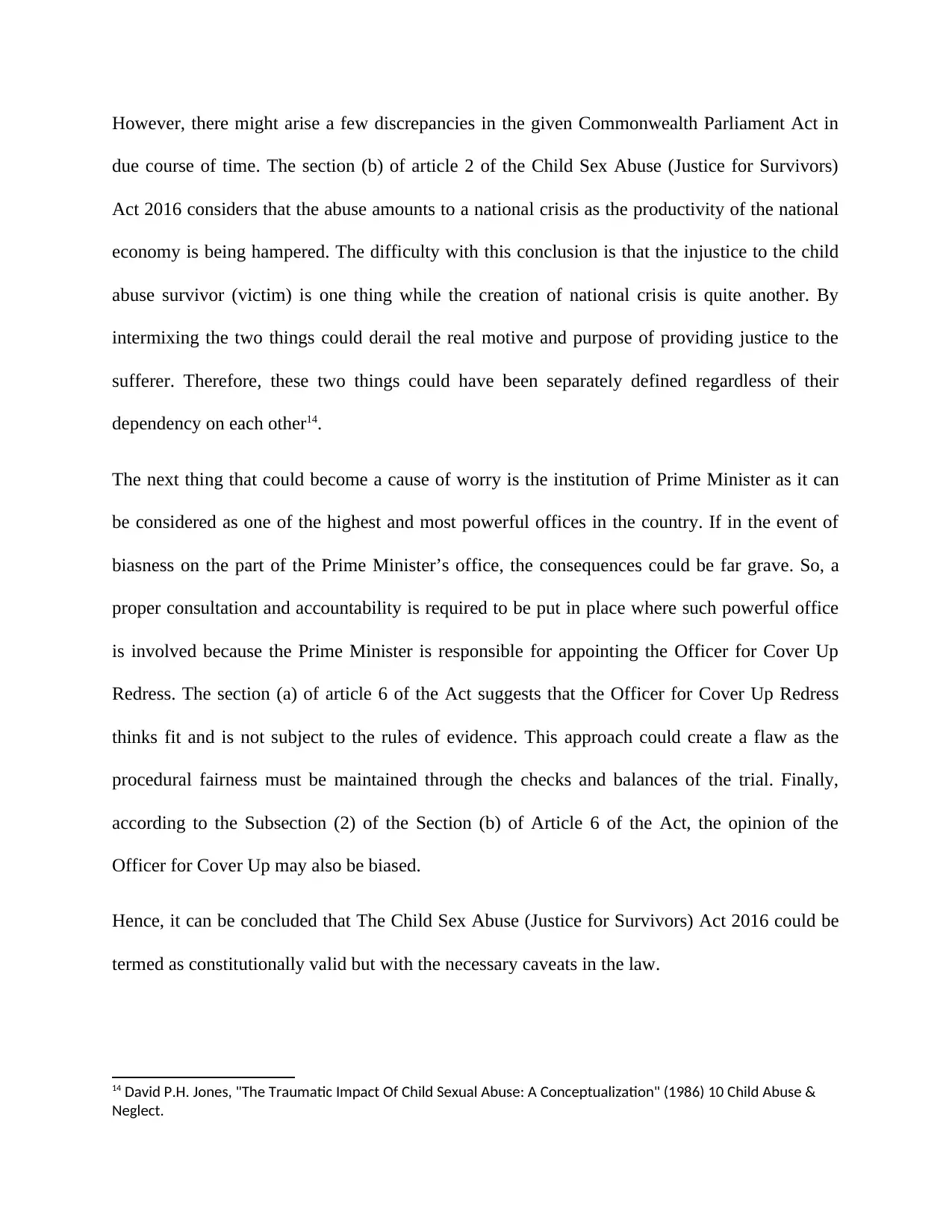
However, there might arise a few discrepancies in the given Commonwealth Parliament Act in
due course of time. The section (b) of article 2 of the Child Sex Abuse (Justice for Survivors)
Act 2016 considers that the abuse amounts to a national crisis as the productivity of the national
economy is being hampered. The difficulty with this conclusion is that the injustice to the child
abuse survivor (victim) is one thing while the creation of national crisis is quite another. By
intermixing the two things could derail the real motive and purpose of providing justice to the
sufferer. Therefore, these two things could have been separately defined regardless of their
dependency on each other14.
The next thing that could become a cause of worry is the institution of Prime Minister as it can
be considered as one of the highest and most powerful offices in the country. If in the event of
biasness on the part of the Prime Minister’s office, the consequences could be far grave. So, a
proper consultation and accountability is required to be put in place where such powerful office
is involved because the Prime Minister is responsible for appointing the Officer for Cover Up
Redress. The section (a) of article 6 of the Act suggests that the Officer for Cover Up Redress
thinks fit and is not subject to the rules of evidence. This approach could create a flaw as the
procedural fairness must be maintained through the checks and balances of the trial. Finally,
according to the Subsection (2) of the Section (b) of Article 6 of the Act, the opinion of the
Officer for Cover Up may also be biased.
Hence, it can be concluded that The Child Sex Abuse (Justice for Survivors) Act 2016 could be
termed as constitutionally valid but with the necessary caveats in the law.
14 David P.H. Jones, "The Traumatic Impact Of Child Sexual Abuse: A Conceptualization" (1986) 10 Child Abuse &
Neglect.
due course of time. The section (b) of article 2 of the Child Sex Abuse (Justice for Survivors)
Act 2016 considers that the abuse amounts to a national crisis as the productivity of the national
economy is being hampered. The difficulty with this conclusion is that the injustice to the child
abuse survivor (victim) is one thing while the creation of national crisis is quite another. By
intermixing the two things could derail the real motive and purpose of providing justice to the
sufferer. Therefore, these two things could have been separately defined regardless of their
dependency on each other14.
The next thing that could become a cause of worry is the institution of Prime Minister as it can
be considered as one of the highest and most powerful offices in the country. If in the event of
biasness on the part of the Prime Minister’s office, the consequences could be far grave. So, a
proper consultation and accountability is required to be put in place where such powerful office
is involved because the Prime Minister is responsible for appointing the Officer for Cover Up
Redress. The section (a) of article 6 of the Act suggests that the Officer for Cover Up Redress
thinks fit and is not subject to the rules of evidence. This approach could create a flaw as the
procedural fairness must be maintained through the checks and balances of the trial. Finally,
according to the Subsection (2) of the Section (b) of Article 6 of the Act, the opinion of the
Officer for Cover Up may also be biased.
Hence, it can be concluded that The Child Sex Abuse (Justice for Survivors) Act 2016 could be
termed as constitutionally valid but with the necessary caveats in the law.
14 David P.H. Jones, "The Traumatic Impact Of Child Sexual Abuse: A Conceptualization" (1986) 10 Child Abuse &
Neglect.
⊘ This is a preview!⊘
Do you want full access?
Subscribe today to unlock all pages.

Trusted by 1+ million students worldwide
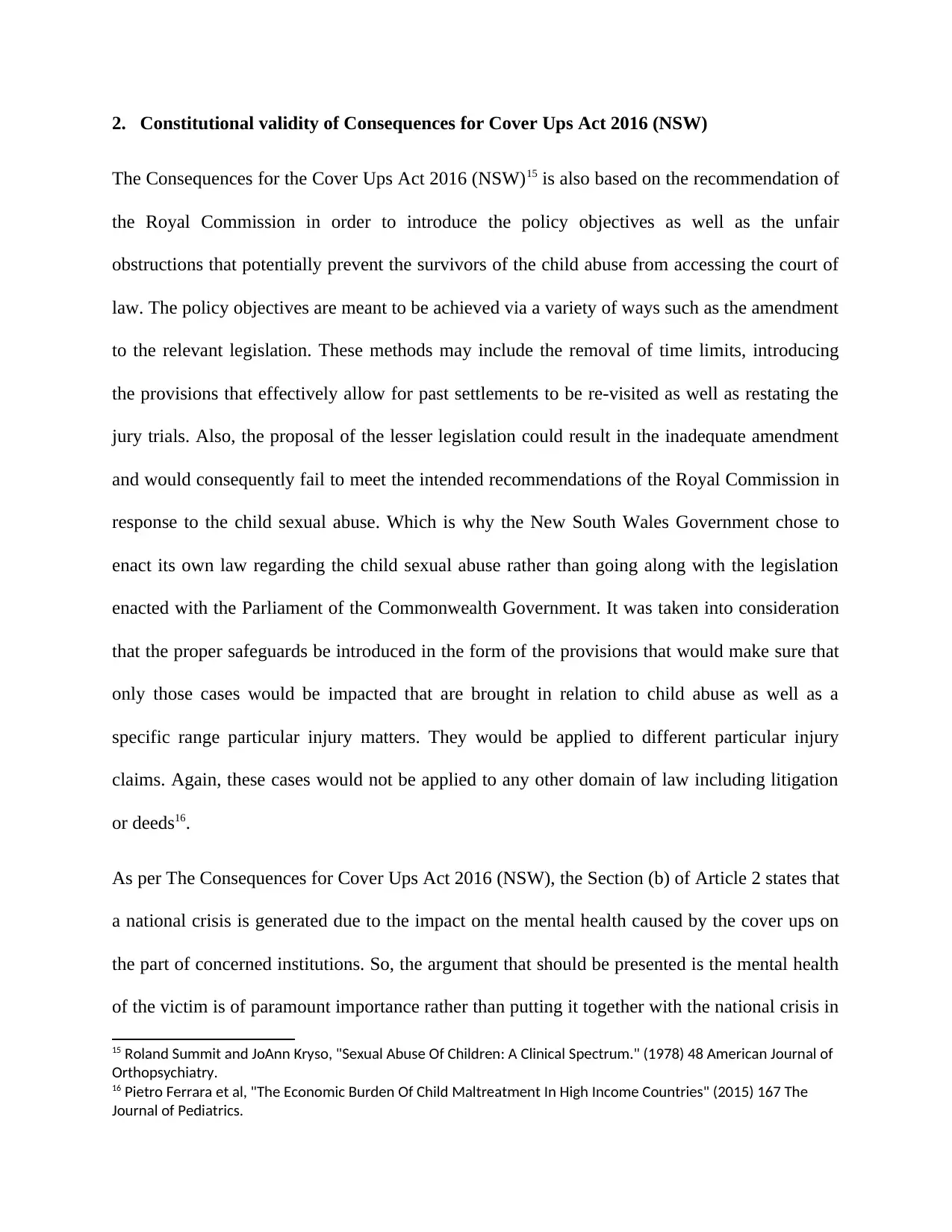
2. Constitutional validity of Consequences for Cover Ups Act 2016 (NSW)
The Consequences for the Cover Ups Act 2016 (NSW)15 is also based on the recommendation of
the Royal Commission in order to introduce the policy objectives as well as the unfair
obstructions that potentially prevent the survivors of the child abuse from accessing the court of
law. The policy objectives are meant to be achieved via a variety of ways such as the amendment
to the relevant legislation. These methods may include the removal of time limits, introducing
the provisions that effectively allow for past settlements to be re-visited as well as restating the
jury trials. Also, the proposal of the lesser legislation could result in the inadequate amendment
and would consequently fail to meet the intended recommendations of the Royal Commission in
response to the child sexual abuse. Which is why the New South Wales Government chose to
enact its own law regarding the child sexual abuse rather than going along with the legislation
enacted with the Parliament of the Commonwealth Government. It was taken into consideration
that the proper safeguards be introduced in the form of the provisions that would make sure that
only those cases would be impacted that are brought in relation to child abuse as well as a
specific range particular injury matters. They would be applied to different particular injury
claims. Again, these cases would not be applied to any other domain of law including litigation
or deeds16.
As per The Consequences for Cover Ups Act 2016 (NSW), the Section (b) of Article 2 states that
a national crisis is generated due to the impact on the mental health caused by the cover ups on
the part of concerned institutions. So, the argument that should be presented is the mental health
of the victim is of paramount importance rather than putting it together with the national crisis in
15 Roland Summit and JoAnn Kryso, "Sexual Abuse Of Children: A Clinical Spectrum." (1978) 48 American Journal of
Orthopsychiatry.
16 Pietro Ferrara et al, "The Economic Burden Of Child Maltreatment In High Income Countries" (2015) 167 The
Journal of Pediatrics.
The Consequences for the Cover Ups Act 2016 (NSW)15 is also based on the recommendation of
the Royal Commission in order to introduce the policy objectives as well as the unfair
obstructions that potentially prevent the survivors of the child abuse from accessing the court of
law. The policy objectives are meant to be achieved via a variety of ways such as the amendment
to the relevant legislation. These methods may include the removal of time limits, introducing
the provisions that effectively allow for past settlements to be re-visited as well as restating the
jury trials. Also, the proposal of the lesser legislation could result in the inadequate amendment
and would consequently fail to meet the intended recommendations of the Royal Commission in
response to the child sexual abuse. Which is why the New South Wales Government chose to
enact its own law regarding the child sexual abuse rather than going along with the legislation
enacted with the Parliament of the Commonwealth Government. It was taken into consideration
that the proper safeguards be introduced in the form of the provisions that would make sure that
only those cases would be impacted that are brought in relation to child abuse as well as a
specific range particular injury matters. They would be applied to different particular injury
claims. Again, these cases would not be applied to any other domain of law including litigation
or deeds16.
As per The Consequences for Cover Ups Act 2016 (NSW), the Section (b) of Article 2 states that
a national crisis is generated due to the impact on the mental health caused by the cover ups on
the part of concerned institutions. So, the argument that should be presented is the mental health
of the victim is of paramount importance rather than putting it together with the national crisis in
15 Roland Summit and JoAnn Kryso, "Sexual Abuse Of Children: A Clinical Spectrum." (1978) 48 American Journal of
Orthopsychiatry.
16 Pietro Ferrara et al, "The Economic Burden Of Child Maltreatment In High Income Countries" (2015) 167 The
Journal of Pediatrics.
Paraphrase This Document
Need a fresh take? Get an instant paraphrase of this document with our AI Paraphraser
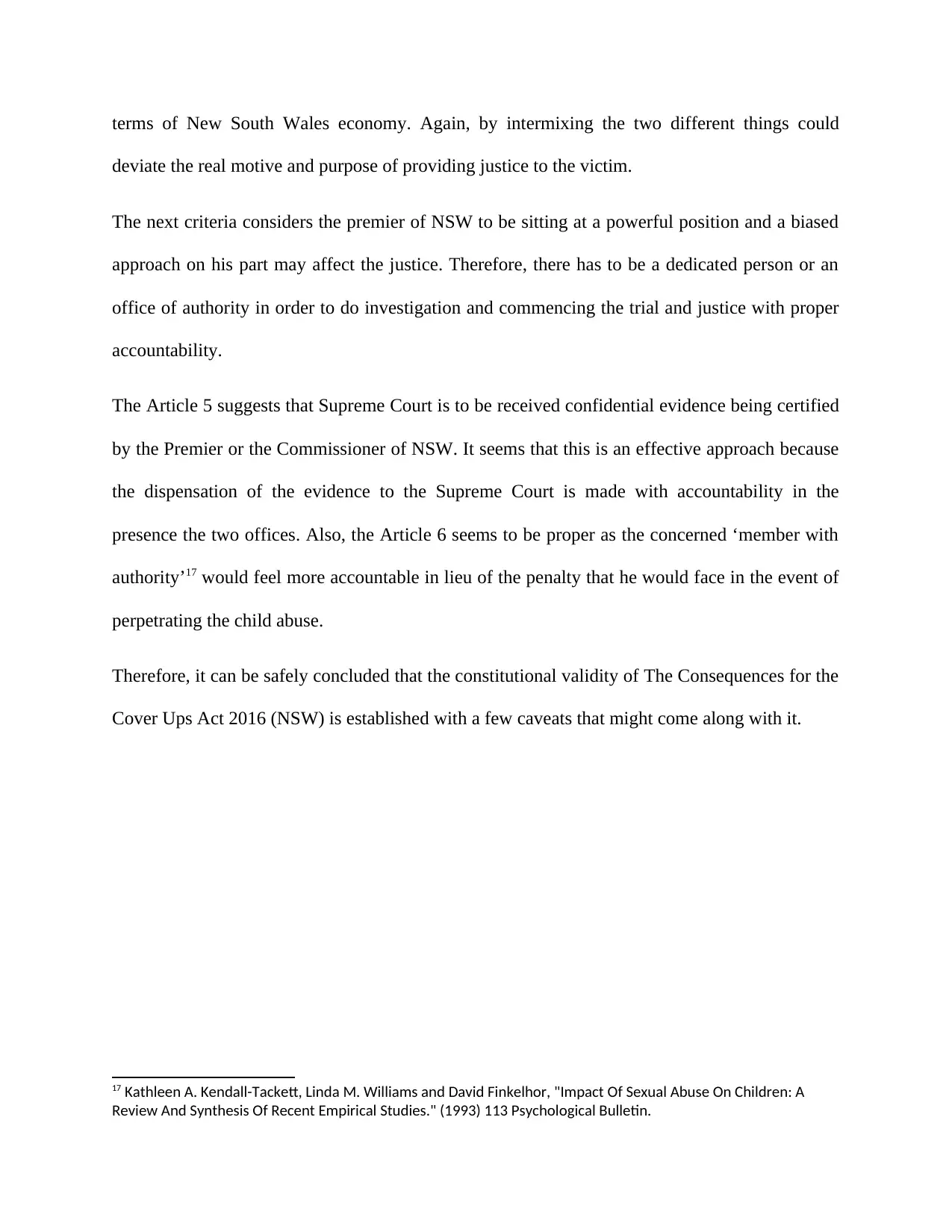
terms of New South Wales economy. Again, by intermixing the two different things could
deviate the real motive and purpose of providing justice to the victim.
The next criteria considers the premier of NSW to be sitting at a powerful position and a biased
approach on his part may affect the justice. Therefore, there has to be a dedicated person or an
office of authority in order to do investigation and commencing the trial and justice with proper
accountability.
The Article 5 suggests that Supreme Court is to be received confidential evidence being certified
by the Premier or the Commissioner of NSW. It seems that this is an effective approach because
the dispensation of the evidence to the Supreme Court is made with accountability in the
presence the two offices. Also, the Article 6 seems to be proper as the concerned ‘member with
authority’17 would feel more accountable in lieu of the penalty that he would face in the event of
perpetrating the child abuse.
Therefore, it can be safely concluded that the constitutional validity of The Consequences for the
Cover Ups Act 2016 (NSW) is established with a few caveats that might come along with it.
17 Kathleen A. Kendall-Tackett, Linda M. Williams and David Finkelhor, "Impact Of Sexual Abuse On Children: A
Review And Synthesis Of Recent Empirical Studies." (1993) 113 Psychological Bulletin.
deviate the real motive and purpose of providing justice to the victim.
The next criteria considers the premier of NSW to be sitting at a powerful position and a biased
approach on his part may affect the justice. Therefore, there has to be a dedicated person or an
office of authority in order to do investigation and commencing the trial and justice with proper
accountability.
The Article 5 suggests that Supreme Court is to be received confidential evidence being certified
by the Premier or the Commissioner of NSW. It seems that this is an effective approach because
the dispensation of the evidence to the Supreme Court is made with accountability in the
presence the two offices. Also, the Article 6 seems to be proper as the concerned ‘member with
authority’17 would feel more accountable in lieu of the penalty that he would face in the event of
perpetrating the child abuse.
Therefore, it can be safely concluded that the constitutional validity of The Consequences for the
Cover Ups Act 2016 (NSW) is established with a few caveats that might come along with it.
17 Kathleen A. Kendall-Tackett, Linda M. Williams and David Finkelhor, "Impact Of Sexual Abuse On Children: A
Review And Synthesis Of Recent Empirical Studies." (1993) 113 Psychological Bulletin.
1 out of 8
Related Documents
Your All-in-One AI-Powered Toolkit for Academic Success.
+13062052269
info@desklib.com
Available 24*7 on WhatsApp / Email
![[object Object]](/_next/static/media/star-bottom.7253800d.svg)
Unlock your academic potential
Copyright © 2020–2025 A2Z Services. All Rights Reserved. Developed and managed by ZUCOL.




